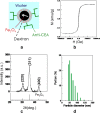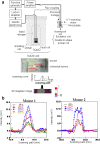Anti-CEA-functionalized superparamagnetic iron oxide nanoparticles for examining colorectal tumors in vivo
- PMID: 24103079
- PMCID: PMC3852279
- DOI: 10.1186/1556-276X-8-413
Anti-CEA-functionalized superparamagnetic iron oxide nanoparticles for examining colorectal tumors in vivo
Abstract
Although the biomarker carcinoembryonic antigen (CEA) is expressed in colorectal tumors, the utility of an anti-CEA-functionalized image medium is powerful for in vivo positioning of colorectal tumors. With a risk of superparamagnetic iron oxide nanoparticles (SPIONPs) that is lower for animals than other material carriers, anti-CEA-functionalized SPIONPs were synthesized in this study for labeling colorectal tumors by conducting different preoperatively and intraoperatively in vivo examinations. In magnetic resonance imaging (MRI), the image variation of colorectal tumors reached the maximum at approximately 24 h. However, because MRI requires a nonmetal environment, it was limited to preoperative imaging. With the potentiality of in vivo screening and intraoperative positioning during surgery, the scanning superconducting-quantum-interference-device biosusceptometry (SSB) was adopted, showing the favorable agreement of time-varied intensity with MRI. Furthermore, biological methodologies of different tissue staining methods and inductively coupled plasma (ICP) yielded consistent results, proving that the obtained in vivo results occurred because of targeted anti-CEA SPIONPs. This indicates that developed anti-CEA SPIONPs owe the utilities as an image medium of these in vivo methodologies.
Figures





References
-
- Bener A. Colon cancer in rapidly developing countries: review of the lifestyle, dietary, consanguinity and hereditary risk factors. Oncol Rev. 2011;8:5–11. doi: 10.1007/s12156-010-0061-0. - DOI
-
- Riley K. FDA: New Warnings Required on Use of Gadolinium-Based Contrast Agents. U.S. Food and Drug Administration: Silver Spring; 2002.
LinkOut - more resources
Full Text Sources
Other Literature Sources

